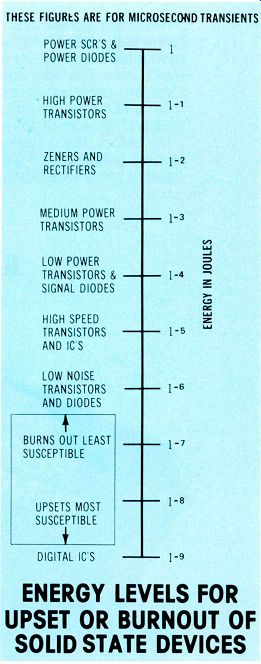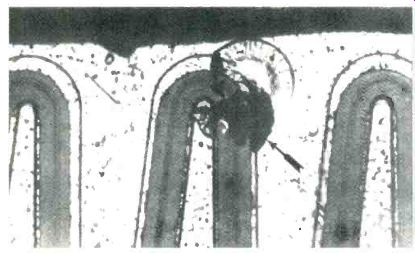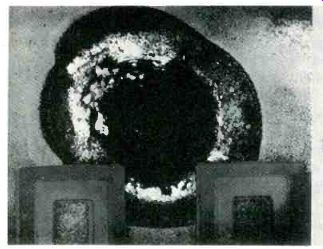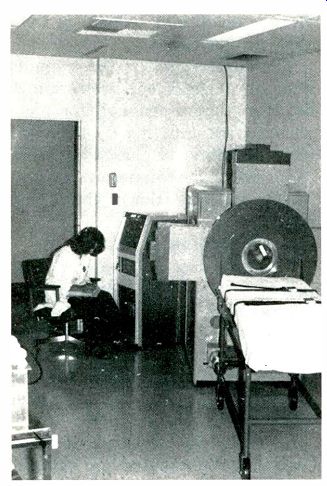Automated manufacturing requires computers and process controllers. The medical field uses electronic machines for monitoring and analyzing patient's conditions. Many businesses depend on mini-computers and word processors to improve communications and expedite the handling of records and inventory figures. Color TV receivers now have a variety of ICs including microprocessors. All of these solid-state-equipped machines are susceptible to damage by line-voltage transients. This article gives one approach for solving the problem.
By Richard Odenberg, Senior Staff Engineer, Transtector Systems
Damages from line-voltage transients cost incalculable millions of dollars annually. Many of these failures are blamed on equipment malfunctions or poor quality control during manufacturing. Seldom are transients identified as the real cause, because transient voltages are the least understood of all electrical phenomena.
It is impossible to eliminate the many origins of transients at this time. They can be formed by fuse blowing, switching loads, inductive ringing, arcing switches and power contactors, power company switching, lightning and more.
Transient voltages have been known almost since the beginning of electrical power. Motors, light bulbs, tube-operated electronic equipment and ac transformers that first were connected to power lines were not sensitive to transients, so the nature and prevention of transients were not investigated.
Solid-state components that now are essential for many products are vulnerable to overvoltage transients.
Figure 1 shows the energy levels that ruin certain types of semi-conductors. Adverse effects from the transients range from momentary upsets of operation-perhaps a wrong calculation from a minicomputer or a false step in a process control-to permanent damage that must be repaired at high cost.
IC failures Large-scale-integration (LSI) ICs are most susceptible to these upsets or damage. However, a high-power SCR can be ruined by a reverse-bias transient that exceeds the rating. So the list of failures include logic upset, data loss, display crashes, mis-triggering of controllers, and damage or destruction of circuit boards. Repairs are expensive and might require a long downtime while components or modules are ordered.

Figure 1--These are the approximate energy levels that either burn out or
upset the performance of various solid-state components. One joule is the
equivalent of one watt for one second. Therefore, an overload of one watt
for .000000001 second (or .000001 watt for .001 second) can interfere with
IC performances in digital circuits. At the other end of the chart, one watt
for one second (or 1000 watts for .001 second) can ruin power SCRs or diodes.
Other ratings are be tween these extremes. All semiconductors can be damaged
by overloads.
ENERGY LEVELS FOR UPSET OR BURNOUT OF SOLID STATE DEVICES---THESE FIGURES ARE FOR MICROSECOND TRANSIENTS

Figure 2--Near the center is the highly magnified blackened area that marks
an emitter-to-base short. All photographs are by the courtesy of Transtector.

Figure 3---This crater-like puncture of an emitter was caused by an overload.
The picture is magnified 620 times.
Internal destruction of ICs can occur instantaneously from a massive overload, or it can result from many less serious transients that degrade the performance before causing a final failure. The Figure 2 and Figure 3 pictures show two types of possible damage in ICs.
For modern solid-state equipment, effective protection against line-voltage transients is imperative.
Transient suppression attempts--Attempts have been made to eliminate voltage transients from the ac-power and signal lines.
However, these transients have a wide variation of repetition rates, energy, amplitude, and pulse width.
This constitutes a complex problem.
Some devices that have been used in attempts to provide clean power are these: uninterruptable power supplies (UPS), isolation transformers, motor-generator supplies, regulation transformers, gas-discharge tubes and spark gaps. Each offers some protection, but also has specific drawbacks of cost or performance.
Some degree of overvoltage protection is claimed by the makers of most electronic equipment. But it has been determined that these devices cannot provide total protection. One reason is that effective transient protection often is sacrificed to obtain a lower price.
Additionally, the number and potential threat of transients are different in various areas of the country. Manufacturers, knowing they cannot protect against all conditions, attempt to protect for average conditions (which, in actuality, do not exist).
The devices used in these limited attempts at transient protection do not react rapidly enough for nano second transients, nor do they have the capability of handling ultra high energy transients without totally shutting down the equipment.

Figure 4--This is one of the UCLA positron-emission computed tomography (ECT)
devices with computers that now are protected against line-voltage transients.
Problems at UCLA
A typical case of transient dam age occurred at the University of California at Los Angeles (UCLA).
It has one of the largest and most advanced schools of medicine and public health and requires the best of equipment for the advanced research that is done there.
In 1976, the Nuclear Medicine Department purchased and installed a $500,000 positron-emission computed tomography device (ECT) that has sophisticated computer hardware (Figure 4). This unit produces images that reflect the true tissue concentration of administered radio-pharmaceuticals in a single selected plane of the body.
The technique is used for the in-vivo measurement of physiological functions and metabolic rates.
According to Tony Ricci, senior development engineer, all worked well for about 18 months, then a continuing series of hardware failures occurred in the nuclear instrumentation modules, with memory alterations and losses in the computer system, along with display crashes and artifacts appearing in the processed images. These occurrences required repeating the affected studies after the equipment was functioning properly.
Ricci called in field service engineers to check the equipment.
UCLA bought quite a few expensive plug-in modules during these at tempts to solve the problems. With in a short time, repair costs exceeded $30,000, not including the time and money lost while the equipment was out of service. During this time, the various problems continued.
Further investigation revealed that the radiology department also was having disturbances in electronic equipment.
The first clue that pointed to the power line as the source of problems was erratic behavior of a power-line clock used for timing experiments performed in conjunction with the physiological monitoring equipment. The clock failed several times, would not keep accurate time, and sometimes counted too fast.
Ricci decided to have the UCLA electrician check the ac power line that supplied the clock. Although the electrician did not have precision equipment for monitoring the line, he found indications of transient voltage surges.
Transient solution UCLA next called in Transtector Systems, a firm specializing in overvoltage protectors. Transtector immediately installed a transient counter on the suspected ac line.
The counter recorded as many as 200 transient spikes per day. Some were short bursts of energy lasting a few nanoseconds, and others were high-energy surges lasting for milli seconds.
Short-term spikes can't be eliminated effectively by slower-acting devices (such as voltage regulators, gas-discharge tubes or spark gaps).
A metal-oxide varistor might allow the transient amplitude to reach 2500V before clamping could begin.
Other types of suppressors cannot handle the longer-term surges carrying thousands of energy watts.
(Transtector has some units that can suppress up to 1,500,000 watts of transient power.) In June, 1978, one Transtector Branch-Service Protector was in stalled for the main line serving UCLA's nuclear medicine scanning department. Also, a smaller unit was installed for each of the two scanners and their computers.
UCLA report
No problems of component failure, display crashes or memory alteration and loss were experienced after the Transtector suppressors were installed. Even the power-line clock began functioning correctly.
The suppressors have been on the ac lines for more than a year without recurrences of the previous problems.
Total cost of the suppressor units was $2316, which is small compared to $500,000 for the ECT equipment, $30,000 for repairs and money lost during downtimes.
Conclusion
This case history, and many similar ones, make clear that systems having ICs and other solid-state components definitely need protection from the various kinds of damage that can (and do) occur-from power-line voltage transients.
First, the dangers of line transients must be recognized. Second, the remedy must prevent all harmful transients from reaching the protected equipment. This is far better than unnecessary repairs.
Technicians in industrial electronic servicing should consider what systems or individual items of equipment should be protected, and then arrange for installation of the protection devices that are appropriate for the equipment and the local conditions.
Technicians who do contract servicing--especially on any digital equipment--are advised to obtain necessary information for bids and installation. And all other technicians should remember these facts about transient voltages and be prepared to take appropriate action when they see the symptoms.
----------- About the product
Transtector manufactures a variety of acV surge suppressors. They are high-speed, high-current solid-state devices that perform by drawing current only from transient voltages above 120% of the nominal line voltage. The spikes are clipped by this conduction that occurs only during the transient; at other times the suppressor draws only about one watt per phase. Suppression begins about five nano seconds after the transient appears. Redundant circuitry operates in stages according to the type of transient. Suppression occurs on both polarities, and for transients generated inside the protected area as well as those riding in on the power line. Models are available for single phase, three-phase delta or Y, and split phase. No adjustments or maintenance are necessary.
Also see:
Preventing damage from transients
Locating AC leakage in industrial plants